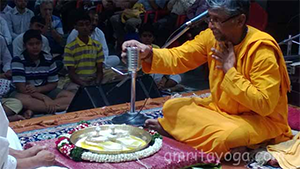 Guru Purnima is a sacred occasion to offer our prayers to our Gurus – to our spiritual masters as well as to our teachers. Words fall short in describing the greatness of a Guru.
Guru Purnima is a sacred occasion to offer our prayers to our Gurus – to our spiritual masters as well as to our teachers. Words fall short in describing the greatness of a Guru.
On this day we perform Guru Paduka puja of our Guru – Amma.
At all of Amma’s Amrita Vidyalayam schools in India, there is also an opportunity to witness the performance of Samskriti puja. This puja is performed to revive the tradition of our ancient land and salutes our first teachers that is our mother then our father.
We know the father’s role is great in the process of bringing up children. But the role of the mother is greater. Experience of many great people have expounded that “Mothers can make all the difference in one’s life”. Children who lack care by parents can be easily recognized. Having not gotten the proper care and nurturing, they will often be very different in their outlook and behavior.
While a sannyasi (monk) is saluted by all those belonging to the other three stages of life i.e. brahmacharya, grhastha and vanaprastha as well by his own father, a sannyasi prostrates to his mother. This convention points out the high esteem accorded to the role of the mother in the Vedic tradition.
The parent-child relationship occupies a special place in one’s life because it begins with one’s birth. A child remains dependent on his or her parents and continues to seek guidance and support from them.
Just as one worships the Gods, one has to look upon one’s mother and father with an attitude of love, worship and respect. We have the examples of so many lives in the Puranas (epics) illustrating dedicated service to one’s parents. It is good to recollect the story of Sravanakumar in the great epic Ramayana. It was while taking his blind parents on his shoulders for a pilgrimage that Sravana kumar was accidentally killed by king Dasaratha.
Also we have the very best example in Lord Rama who is the ideal son, the ideal husband, and the ideal king. Lord Rama unflinchingly followed his father’s order to go to the forest. This was an expression of his love and value for ‘pitrvakya paripalana’, protecting the words of one’s father.
In today’s world it is not possible for one to carry one’s parents on one’s shoulders. Is it not possible to at least worship them?
Samskriti puja is one of the most beautiful ways to bring about devotion towards one’s parents. This puja is called kayika karma. Here, the body, mind and speech are all involved. The fragrances and sounds of various items of worship arrest one’s mind and aid in evoking devotion in oneself. Many parents and students say that this puja creates a different ambience and feeling in them.
This puja is being performed to express one’s gratitude towards one’s parents and also to Isvara (God or Absolute) for all one has been given in life. The body mind sense complex is made up of 5 basic elements which also constitute the creation. The worship acknowledges the presence of the lord and makes a simple offering of the 5 elements through a symbolic offering of pushpa (flowers) representing the space element; dhupa (incense) representing the air element, dipa (light) representing the fire element, naivedya (food) representing water element and gandha (sandalwood paste) representing the earth element.
These days we notice many Indian children have moved away from the culture and are increasingly becoming arrogant with little concern for their parents. This type of puja brings an attitude of humility and allows the children to see the greatness of their parents. The one who has humility does not take anything for granted. He treats everyone and everything with great respect.
This day, we invoke the lord’s blessings by offering our prayers to parents who are the pratyaksha devatas. ‘Prarthana’ the Sanskrit word for prayer is the highest form of communication with the lord. Prayers help in the purification of the mind and to obtain the lord’s grace. The removal of afflictions which include improper thinking and emotions that cause distress is brought about by the process of praying. We pray to the lord in the form of simple words or as an elaborate ritual.
Like any other action, prayer produces a result. The result is two-fold: One is drsthaphala (immediately seen) and the other is adrsthaphala (unseen). The immediate result of prayer is the inner comfort that comes from acknowledging one’s limited capacities. The unseen result of prayer refers to the subtle result called punya (merit). This punya manifests in the form of comfortable situations in this life or later.
Prayer is expressed in 3 ways:
Kayika karma – a ritual or a puja is a physical form of prayer
Vachika karma – chanting verses and vedic hymns is an oral prayer
Manasa puja – meditation done silently is mental prayer
At all the Amrita Vidyalayam schools in India, by the Divine Grace of our beloved Amma we have this unique opportunity to do such puja together. May the ancient tradition and culture of Bharath be always honored and may all the generations of our lineage hold to this highest mano bhavana (attitude) in their lives. May such mano bhavana bring peace and contentment to all beings.
Author: Brahmacharini Shobhana

0 Comments